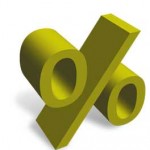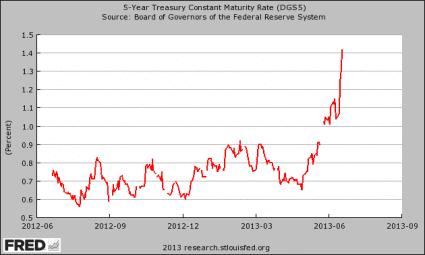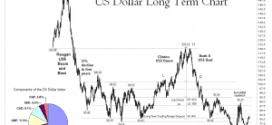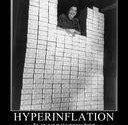The global financial system is potentially heading for massive amounts of trouble if interest rates continue to soar. So what does all this mean exactly? [Let me explain.]
interest rates continue to soar. So what does all this mean exactly? [Let me explain.]
So writes Michael Snyder in edited excerpts from his original article* entitled The 441 TRILLION Dollar Interest Rate Derivatives Time Bomb.
[The following article is presented by Lorimer Wilson, editor of www.munKNEE.com and may have been edited ([ ]), abridged (…) and/or reformatted (some sub-titles and bold/italics emphases) for the sake of clarity and brevity to ensure a fast and easy read. This paragraph must be included in any article re-posting to avoid copyright infringement.]
Snyder goes on to say in further edited excerpts:
Interest Rates Rising Rapidly
Most people might think that the primary reason why rapidly rising interest rates could take down the entire global financial system would be because:
- the U.S. government would have to pay much more interest on the national debt. Yes, if the average rate of interest on U.S. government debt rose to just 6 percent (and it has actually been much higher in the past), the federal government would be paying out about a trillion dollars a year just in interest on the national debt – but that isn’t it.
- The rapidly rising interest rates would impose massive losses on bond investors. At this point, it is being projected that if U.S. bond yields rise by an average of 3 percentage points, it will cause investors to lose a trillion dollars. Yes, that is a 1 with 12 zeroes after it ($1,000,000,000,000) – but that is not the number one danger…either [but]
- The number one reason…is [actually] because there are more than 441 TRILLION dollars worth of interest rate derivatives sitting out there. This number comes directly from the Bank for International Settlements – the central bank of central banks….Normally these bets do not cause a major problem because rates tend to move very slowly and the system stays balanced but now rates are starting to skyrocket, and the sophisticated financial models used by derivatives traders do not account for this kind of movement.
10-year U.S. Treasury Bonds
[As] the chart posted below shows, the yield on 10-year U.S. Treasury bonds rocketed up to 2.66% before settling back to 2.55%…in recent days…Right now, the yield on 10-year U.S. Treasuries is about 30% above its 50-day moving average. That is the most that it has been above its 50-day moving average in 50 years. We are moving into uncharted territory and this data doesn’t really fit into the models used by derivatives traders.
5-year U.S. Treasury Bonds
The yield on 5 year U.S. Treasuries has been moving even more dramatically:
Last week, the yield on 5-year U.S. Treasuries rose by an astounding 37%. That was the largest increase in 50 years. Once again, this is uncharted territory.
If rates continue to shoot up, there are going to be some financial institutions out there that are going to start losing absolutely massive amounts of money on interest rate derivative contracts.
What Is An Interest Rate Derivative?
The following is how Investopedia defines an interest rate derivative:
“A financial instrument based on an underlying financial security whose value is affected by changes in interest rates. Interest-rate derivatives are hedges used by institutional investors such as banks to combat the changes in market interest rates. Individual investors are more likely to use interest-rate derivatives as a speculative tool – they hope to profit from their guesses about which direction market interest rates will move.”
Interest rate derivatives can be very complicated, but I prefer to think of them in very simple terms. Just imagine walking into a casino and placing a bet that the yield on 10-year U.S. Treasuries will hit 2.75% in July. If it does reach that level, you win. If it doesn’t, you lose. That is a very simplistic example, but I think that it is a helpful one.
At the heart of it, the 441 TRILLION dollar derivatives market is just a bunch of people making bets about which way interest rates will go and, normally, the betting stays very balanced and our financial system is not threatened. The people that run this betting use models that are far more sophisticated than anything that Las Vegas uses but all models are based on human assumptions, and wild swings in interest rates could break their models and potentially start causing financial losses on a scale that our financial system has never seen before. We are potentially talking about a financial collapse far worse than anything that we saw back in 2008.
Remember, the U.S. national debt is just now approaching 17 trillion dollars so when you are talking about 441 trillion dollars you are talking about an amount of money that is almost unimaginable…
The U.S. financial system is a massive Ponzi scheme that is on the verge of imploding. Nobody knows for sure what happens next, but one thing seems certain, the last half of 2013 is shaping up to be very, very interesting.
[Editor’s Note: The author’s views and conclusions in the above article are unaltered and no personal comments have been included to maintain the integrity of the original post. Furthermore, the views, conclusions and any recommendations offered in this article are not to be construed as an endorsement of such by the editor.]
* http://theeconomiccollapseblog.com/archives/the-441-trillion-dollar-interest-rate-derivative-timb-bomb
Related Articles:
1. Rising Interest Rates Could Plunge Financial System Into a Crisis Worse Than 2008 – Here’s Why
If yields on U.S. Treasury bonds keep rising, things are going to get very messy. What we are ultimately looking at is a sell-off very similar to 2008, only this time we will have to deal with rising interest rates at the same time. The conditions for a “perfect storm” are rapidly developing, and if something is not done we could eventually have a credit crunch unlike anything that we have ever seen before in modern times. Let me explain. Read More »
2. We Think Interest Rates are Making a Long-term Turn Upwards
We had previously speculated that the 30-year bond rate would continue downward to around 2% based upon a number of very long-term charts. Short-term charts, however, are showing strong technical evidence that interest rates may be turning up in the long term. Words: 267; Charts: 2 Read More »
3. What Will Cause Interest Rates to Rise? Will That Be Good or Bad?
Don’t get too worked up over interest on the national debt or what will happen when interest rates rise because, by then, we’ll likely be talking about ways to cool down the economy. [Why?] Because interest rates on US government debt are really a function of economic growth. If the economy is weak the Fed will pin short rates to stimulate the economy and if rates rise it’s going to be a function of better days ahead. Words: 525
4. A Rise in Interest Rates Would Derail An Economic Recovery – Yes or No?
[While]… I am not currently predicting an acceleration in inflation [I believe]…that the risk of interest rate instability is very real [given that] core inflation is already above a key benchmark that the Fed has staked its credibility on,. It should be of concern to investors that, despite economic growth being so anemic and overall resource utilization being so low (including human resources), there is currently very little margin for error on the inflation front. [In this article the author evaluates the danger that rising interest rates could potentially have on the U.S. economy.] Words: 20505. Soros Sees Interest Rates Soaring Soon – What Does That Mean for Bonds & Gold?
The U.S. economy is picking up steam and the Fed’s quantitative-easing approach is helping and as a result investors should watch out for a possible spike in interest rates once growth is well under way (later this year) warns billionaire financier George Soros. It has been suggested that this would adversely affect bonds but not everyone agrees. Read on!
At some point we are going to see another wave of panic hit the financial markets like we saw back in 2008. The false stock market bubble will burst, major banks will fail and the financial system will implode. It could unfold something like this: Words: 660 Read More »
7. U.S. Financial System Will Die When Interest Rates Rise! Here’s Why
 munKNEE.com Your Key to Making Money
munKNEE.com Your Key to Making Money




Rising interest rates will continue to put the brakes on any fiscal recovery because it will only make loans harder to get and further limit the number of borrowers that qualify for a loan!
This is financial war against the middle class who are at the mercy of Big Banks that are getting their money at almost zero interest from the Fed.
In order to turn our economy around, we need to lower the rates that Big Banks charge to one or one and a half percent over what the Big Banks are paying, anything else is just highway robbery!